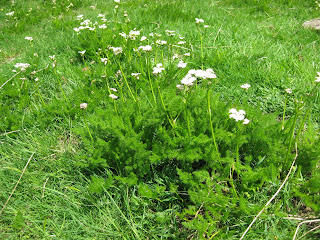Our field visit yesterday included representatives from the Countryside Council for Wales, North Wales Wildlife Trust, RSPB and BSBI as well as interested local botanists. The spotted rock rose (Tuberaria guttata) is Anglesey's county flower and very restricted on a few sites (it is also found in Wales on one site on the Lleyn peninsula, and a few scattered sites in Ireland and the Channel Isles). Organisations like the RSPB and the Wildlife Trust, which own some of the sites, have been carrying out regular counts for some years, while other sites in private ownership are less often visited. While meeting on a site, we aimed to carry out some survey and also agree a consistent method to be applied at all the sites, by a range of different people. The discussion was fairly wide-ranging including questions of whether counting colonies or populations is useful (it probably depends upon the number - with large numbers estimates are necessary); whether tiny plants should be counted equally with large ones, and how to draw a sketch map or take a useful photograph.
 |
| Discussion around a patch of Tuberaria |
The management and monitoring of an annual species which can be subject to large natural fluctuations in population size causes some difficulties. As does the counting. In the photograph below the two plants with flowers on are obvious. What about the 30+ other plants? All of these will also produce flowers although each flower only lasts a few hours. Around lunch time one can watch as a flower suddenly loses all its petals within seconds.
 |
| Two flowers, and over 30 non-flowering plants |
Another Anglesey speciality was
Viola lactea - pale dog violet - identified in Anglesey by its truncate to cuneate leaf bases (never cordate as in
Viola riviniana).
 |
| Viola lactea |









